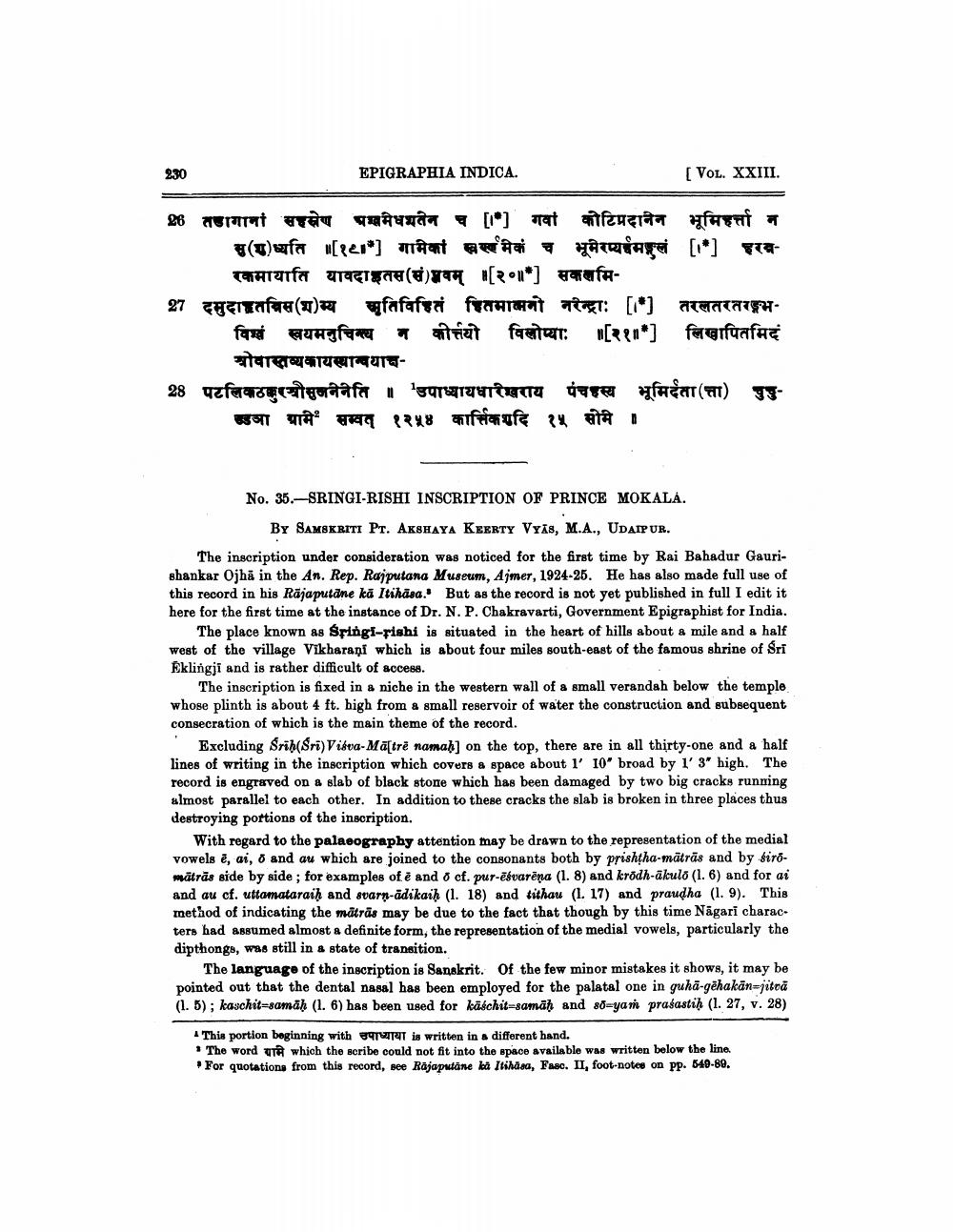________________
230
EPIGRAPHIA INDICA.
[ VOL. XXIII.
28 तळागानां सहस्रेण पबमधशतेन च [1] गवा कोटिप्रदानेन भूमिहर्ता न (u)fa [pera] at an
ATHARI [1] Fiat TATUTA UTAFITE (E) ETH [2018] UA27 Fugleaf(T)R fafafea f eat TirT: [*] H atu
विश्वं स्वयमनुचिन्त्य न कीर्तयो विलोप्याः [२१॥*] लिखापितमिदं
श्रीवास्तव्यकायस्थावयाच28 पटलिकठारचौसुननेनेति ॥ 'उपाध्यायधारेवराय पंचहस्य भूमिर्दता(त्ता) पुत्रु
खडा ग्राम सम्बत् १२५४ कार्तिकशदि १५ सोमे ।
No. 35.-SRINGI-RISHI INSCRIPTION OF PRINCE MOKALA.
BY SAMSKRITI PT. AKSHAYA KEERTY VYAS, M.A., UDAIPUR. The inscription under consideration was noticed for the first time by Rai Bahadur Gaurishankar Ojhā in the An. Rep. Rajputana Museum, Ajmer, 1924-25. He has also made full use of this record in his Rājaputāne kā Itihasa. But as the record is not yet published in full I edit it here for the first time at the instance of Dr. N. P. Chakravarti, Government Epigraphist for India.
The place known as śpingi-fishi is situated in the heart of hills about a mile and a half west of the village Vikharani which is about four miles south-east of the famous shrine of Sri Eklingji and is rather difficult of access.
The inscription is fixed in a niche in the western wall of a small verandah below the temple whose plinth is about 4 ft. high from a small reservoir of water the construction and subsequent consecration of which is the main theme of the record.
Excluding Srih(Sri) Visva-Māstre namah] on the top, there are in all thirty-one and a half lines of writing in the inscription which covers a space about 1' 10" broad by 1' 3" high. The record is engraved on & slab of black stone which has been damaged by two big cracks running almost parallel to each other. In addition to these cracks the slab is broken in three places thus destroying portions of the inscription.
With regard to the palaeography attention may be drawn to the representation of the medial vowels e, ai, 8 and au which are joined to the consonants both by prishtha-mātrās and by firomätrās side by side ; for examples of ē and o cf. pur-ēsvarēna (1. 8) and krõdh-akulo (1.6) and for ai and au cf. uttamataraiḥ and svarn-ādikaih (1. 18) and tithau (1. 17) and praudha (1. 9). This method of indicating the matrās may be due to the fact that though by this time Nägari characters had assumed almost a definite form, the representation of the medial vowels, particularly the dipthongs, was still in a state of transition.
The language of the inscription is Sanskrit. Of the few minor mistakes it shows, it may be pointed out that the dental nasal has been employed for the palatal one in guhā-gehakān=jitoa (1. 5); kaschit=samah (1. 6) has been used for kāschit=samāħ and 80=yan prasastih (1. 27, v. 28)
This portion beginning with W T is written in a different hand. • The word which the scribe could not fit into the space available was written below the line. For quotations from this record, see Rajaputāne ka Itihasa, Faso. II, foot-notes on Pp. 340-89.




